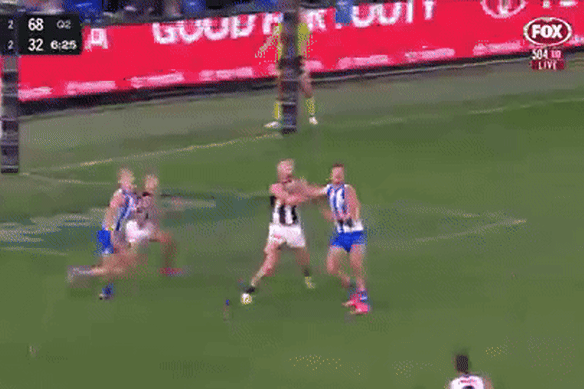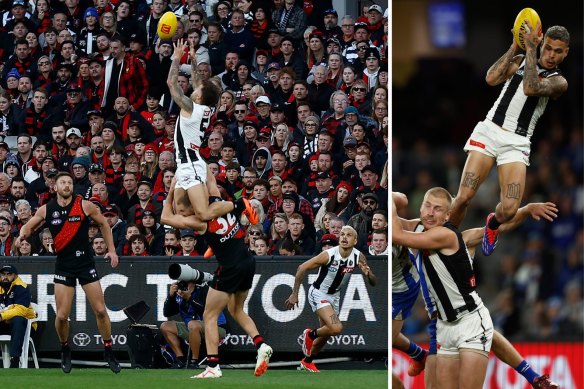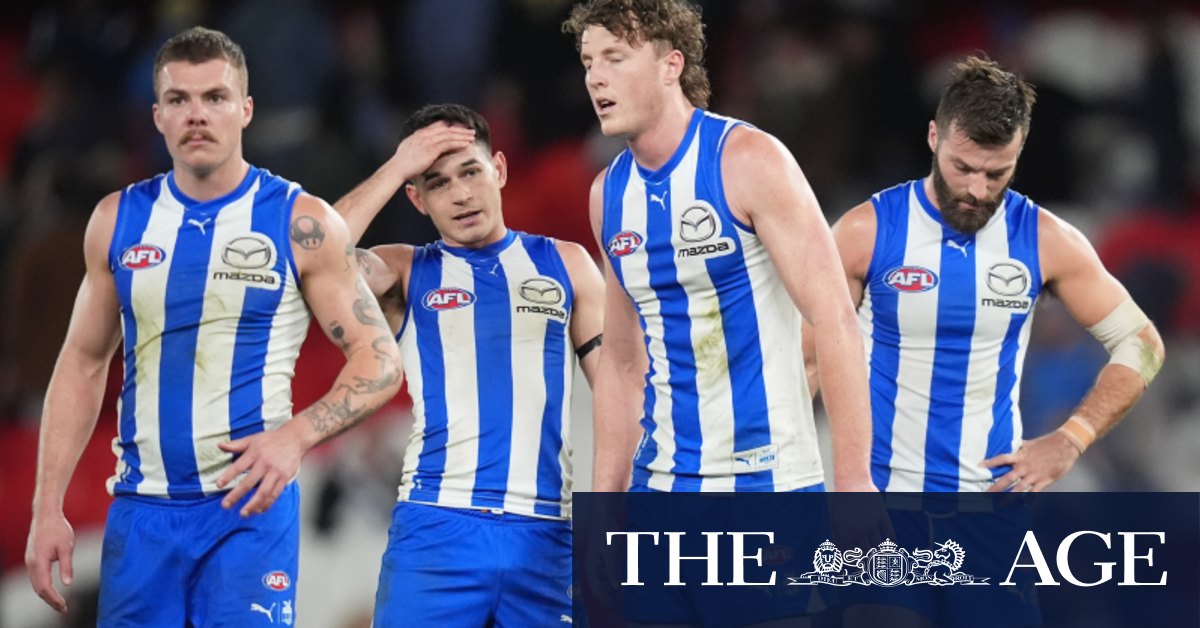“Neither of those two calls occurred in the immediate moments after the whistle was blown and Bailey takes four steps or so inbound, and looks to play on.
“The correct call should have been ‘play on’ initially – that has caused confusion for the players in the immediate vicinity, being the Collingwood players, that there was a delay. The communication was the error, I guess.”
Kane said if the umpire had called “stand” immediately and the two Collingwood players had closed on Scott, then it would have been a 50-metre penalty.
“The initial mistake, if you like, is that ‘play on’ wasn’t called,” she said on the AFL website.
“‘What’s next’ didn’t come quick enough … every objective marker of ‘play on’ was there.”
Kane also backed how another incident was adjudicated earlier in the game, also involving Scott.
Collingwood’s Jack Crisp snapped a goal, but a replay shows Scott might have touched it off the boot.
Kane said the goal was reviewed in the league’s video hub.
“We need certainty in the ARC [AFL review centre] and our score reviewers need to see, and be certain, that the vision shows very clearly that the ball was touched,” Kane said
“We didn’t have that certainty – it is a line-ball call.
“We were happy with the process – I understand how you would get to either outcome.
“They didn’t have definitive vision or a definitive image to overturn the call.”
AAP
Elliott v Hill: Who wins mark of the year, and could the speccy be outlawed?
Peter Ryan
High-flying Magpie Jeremy Howe admits he’d be worried if he was Jamie Elliott that Bobby Hill’s second quarter screamer against North Melbourne might top Elliott’s Anzac Day speccy to win the mark of the year.
Elliott’s mark over Essendon’s Ben McKay at the MCG on Anzac Day was considered unbeatable until Hill took to the skies at the tip of the goal square at Marvel Stadium and stood on the shoulders of teammate Billy Frampton and Kangaroos defender Charlie Comben to take a remarkable grab.
Jamie Elliott’s Anzac Day grab over Essendon’s Ben McKay.Credit: Channel Seven
“I’d be nervous if I was Jamie,” Howe said. “I think Bobby’s was better.”
The king of high marks, who was robbed of mark of the year in 2017 when a popular vote handed then-Essendon forward Joe Daniher the award, admitted that taking such a big grab on Anzac Day in front of 93,644 fans as Elliott did might give him the edge, but he was prepared to make a case for Hill’s mark.

Bobby Hill takes a screamer in the second quarter of Sunday’s game against North Melbourne.Credit: Fox Sports
“Maybe not the occasion, but [Hill] even dusted his head as if he hit the roof. It was an impressive grab,” Howe said.
“He goes for a few, maybe some unrealistic but that one he managed to stay up, collect it up there and bring it down. It was good to see.”
Both Elliott and Hill finished their work with goals, which evens the score, and their coach Craig McRae was not as willing to split the marks as Howe was to put doubt in Elliott’s mind.

Collingwood teammates Jamie Elliott (left, on Anzac Day) and Bobby Hill (on Sunday) have taken two of the leading contenders for this year’s mark of the year award.Credit: AFL Photos
“Oh that was good one, wasn’t it,” McRae said of Hill’s mark when asked before making the classic coaching shift to talk about the small forward’s GPS numbers.
Howe knows it is not just skill but courage that is required when flying for such marks.
“Counterbalance is a bit of an issue. If he got pushed to the side, and he goes lateral, then it is a different game, game over, and you probably hurt yourself, but he was able to control it,” Howe said.
Hill also managed a brave mark in the dying minutes, which allowed him to kick his fifth goal and give Collingwood the lead once again.
The debate over which screamer was best came as AFL Legend Leigh Matthews wondered whether the high mark, a feature of Australian rules, could go the way of the high bump or the dangerous tackle in being outlawed because of the risk of concussion to an opponent.
Matthews was referring to footage of Sydney’s Will Hayward flying for a mark, when his knee crashed into the back of his Crows opponent’s head.
“Fifteen years ago a heavy tackle where you dumped someone into the ground was just good play, not even a free kick, now it’s reportable,” Matthews said on Nine’s Footy Furnace on Sunday night.
Loading
“I just wonder … in trying to prevent brain injuries, whether jumping knee-first into a marking contest will eventually be outlawed.”
Age columnist Kane Cornes has predicted an end to spectacular high marks as the AFL makes the game safer.
“No bumping. No tackling. No smothering. And soon no spectacular, high-flying marks,” Cornes wrote in March after the league released revised concussion protocols.
“The AFL’s relentless pursuit of safety and the mounting legal cases threatens to strip the very essence of the game. Fans can ponder a future devoid of collisions, contests, big smothers and high-flying heroics that once defined it.”

